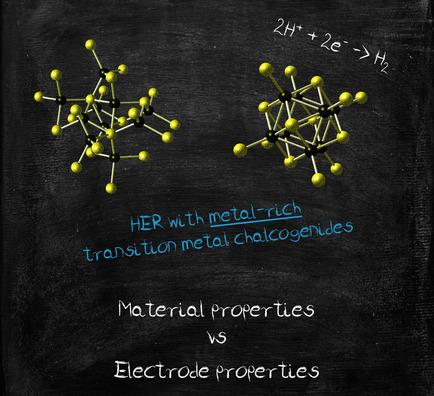当前位置:
X-MOL 学术
›
ChemElectroChem
›
论文详情
Our official English website, www.x-mol.net, welcomes your feedback! (Note: you will need to create a separate account there.)
Metal‐Rich Chalcogenides for Electrocatalytic Hydrogen Evolution: Activity of Electrodes and Bulk Materials
ChemElectroChem ( IF 4 ) Pub Date : 2020-03-09 , DOI: 10.1002/celc.201902125 Daniel Siegmund 1 , Niclas Blanc 2 , Mathias Smialkowski 3 , Kristina Tschulik 2 , Ulf‐Peter Apfel 1, 3
ChemElectroChem ( IF 4 ) Pub Date : 2020-03-09 , DOI: 10.1002/celc.201902125 Daniel Siegmund 1 , Niclas Blanc 2 , Mathias Smialkowski 3 , Kristina Tschulik 2 , Ulf‐Peter Apfel 1, 3
Affiliation

|
Metal‐rich chalcogenides composed of highly abundant elements recently emerged as promising catalysts for the electrocatalytic hydrogen evolution reaction (HER). Many of these materials benefit from a high intrinsic conductivity as compared to their chalcogen‐rich congeners, greatly reducing the necessity for conductive additives or sophisticated nanostructuring. Herein, we showcase the high potential of metal‐rich transition‐metal chalcogenides for the electrocatalytic hydrogen formation by summarizing the recent progress achieved with M9S8 (pentlandite type) and M3S2 (heazlewoodite type) based materials, which represent the most frequently applied compositions for this purpose. By a detailed electrochemical comparison of bulk as well as pellet electrodes of metal‐rich Fe4.5Ni4.5S8, we also aim at raising awareness in the community for the inherent differences in catalytic properties of the materials themselves and those of the fabricated electrodes, a point that is often disregarded in reports on HER‐catalyst systems.
中文翻译:

富金属硫属元素化物用于电催化氢逸出:电极和散装材料的活性
最近,由高度丰富的元素组成的富含金属的硫属元素化物成为有希望的电催化放氢反应(HER)催化剂。与富含硫族元素的同类材料相比,这些材料中的许多材料都具有较高的固有电导率,从而大大降低了导电添加剂或复杂的纳米结构的必要性。在此,我们通过总结M 9 S 8(五方铁矿型)和M 3 S 2的最新研究成果,展示了富含金属的过渡金属硫属元素化物在电催化氢形成方面的巨大潜力。(heazlewoodite型)基材料,代表用于此目的的最常用组合物。通过对富金属的Fe 4.5 Ni 4.5 S 8的块状和颗粒电极进行详细的电化学比较,我们还旨在提高社区对材料本身和制成电极的固有催化性能差异的认识,关于HER催化剂系统的报告中经常忽略这一点。
更新日期:2020-03-09
中文翻译:

富金属硫属元素化物用于电催化氢逸出:电极和散装材料的活性
最近,由高度丰富的元素组成的富含金属的硫属元素化物成为有希望的电催化放氢反应(HER)催化剂。与富含硫族元素的同类材料相比,这些材料中的许多材料都具有较高的固有电导率,从而大大降低了导电添加剂或复杂的纳米结构的必要性。在此,我们通过总结M 9 S 8(五方铁矿型)和M 3 S 2的最新研究成果,展示了富含金属的过渡金属硫属元素化物在电催化氢形成方面的巨大潜力。(heazlewoodite型)基材料,代表用于此目的的最常用组合物。通过对富金属的Fe 4.5 Ni 4.5 S 8的块状和颗粒电极进行详细的电化学比较,我们还旨在提高社区对材料本身和制成电极的固有催化性能差异的认识,关于HER催化剂系统的报告中经常忽略这一点。



























 京公网安备 11010802027423号
京公网安备 11010802027423号